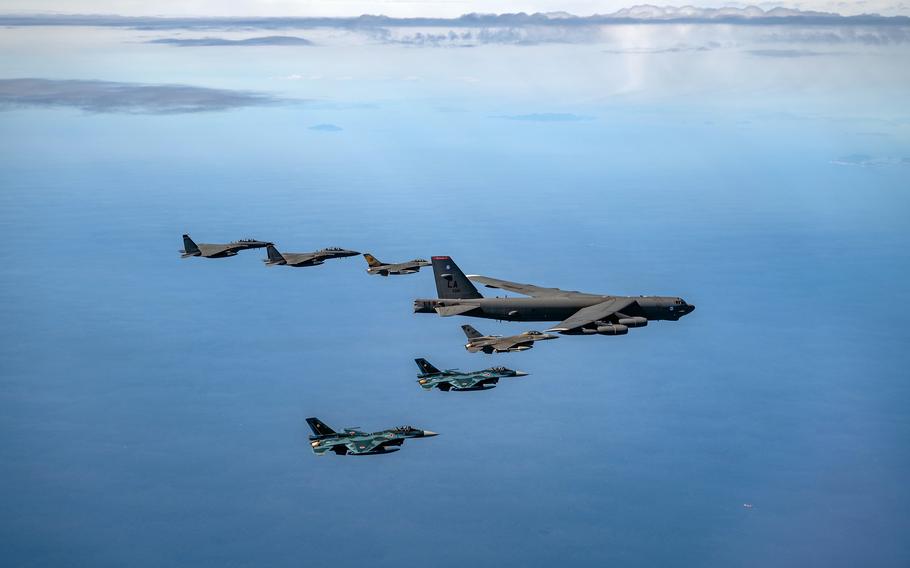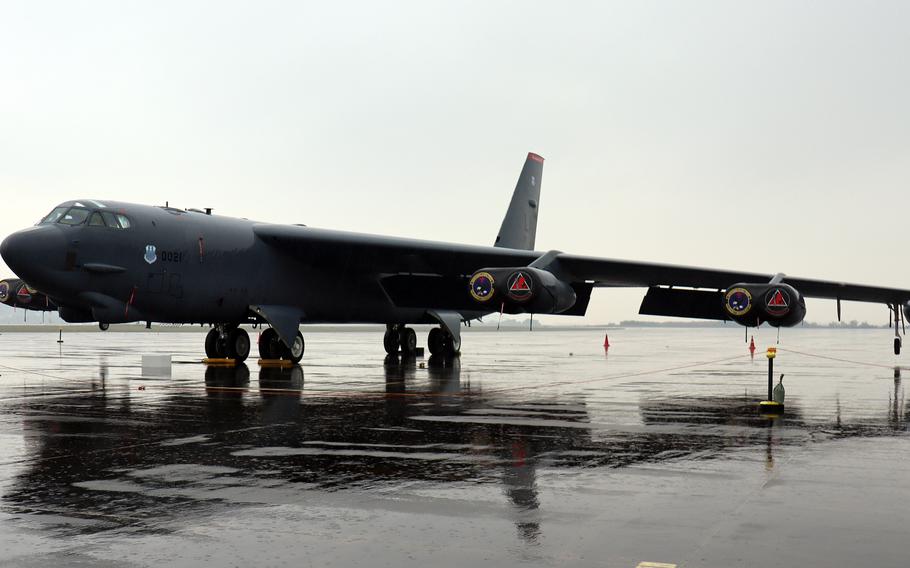
An Air Force B-52H Stratofortress bomber and F-16 Fighting Falcons fly alongside South Korean F-15K Slam Eagles and Japanese F-2s south of the Korean Peninsula, Oct. 22, 2023, during the three nations' first-ever aerial drill together. (South Korean air force)
CAMP HUMPHREYS, South Korea — The U.S., South Korean and Japanese air forces have carried out a rare aerial drill involving a nuclear-capable bomber as part of their nations’ agreement to expand military cooperation amid growing threats out of Pyongyang.
For the first time, a B-52H Stratofortress bomber; two F-16 Fighting Falcons; two South Korean F-15K Slam Eagles; and two Japanese F-2s flew alongside one another Sunday, the South Korean air force announced in a news release that day. The historic drill took place in air-defense zones south of the Korean Peninsula that overlap Japan and South Korea.
The three militaries “demonstrated their security cooperation and solidarity” with the drill, and the South Korean air force will continue to collaborate with the United States and Japan, according to the release.
U.S. Indo-Pacific Command said in a statement Sunday that the drill “builds on the continued interoperability of our collective forces and demonstrates the strength of the trilateral relationship with our Japan and [South Korean] allies.”
Interoperability is a term used by the military to describe the ability of one nation’s military to use another’s training methods and equipment.
“Our international cooperation is reflective of our shared values and resolve against those who challenge regional stability,” the INDOPACOM statement said. “We remain committed to peace and prosperity in the region to uphold a free and open Indo-Pacific.”
U.S. Ambassador to South Korea Philip Goldberg described the drill as “a testament to our unwavering resolve.”

An Air Force B-52H Stratofortress assigned to the 96th Bomb Squadron out of Barksdale Air Force Base, La., sits on the flightline at Cheongju International Airport, South Korea, Oct. 19, 2023. (David Choi/Stars and Stripes)
“This collaboration marks a new era of defense partnership and credible deterrence,” he wrote Monday on X, formerly known as Twitter.
The U.S. F-16s are from the 8th Fighter Wing out of Osan Air Base, south of Seoul, and the B-52H is assigned to the 96th Bomb Squadron out of Barksdale Air Force Base, La.
The bomber landed in South Korea on Oct. 17 — the first time a B-52 touched down on the peninsula in at least 30 years — to perform flyovers with South Korean F-35A Lightning IIs during Seoul’s Aerospace and Defense Exhibition that week.
It’s common for U.S. bombers to drill separately with Japanese and South Korean fighters as shows of force following North Korean nuclear tests.
For example, a B-52H and four F-16s flew alongside three South Korean F-15s near the peninsula on July 13, a day after North Korea fired an intercontinental ballistic missile that was in the air for 74 minutes, a flight record for the communist regime.
On Aug. 30, two U.S. B-1 Lancer bombers flew with eight Japanese F-2s and four F-15 fighters over the Sea of Japan, or the East Sea, to show “our alliance’s ability to quickly and decisively respond to threats against Japan and the region,” according to a statement from U.S. Forces Japan.
That day, at least one B-1 and an unspecified number of South Korean FA-50 fighters flew alongside each other over the Yellow Sea, according to South Korea’s Ministry of National Defense.
North Korea has fired 21 ballistic missiles — four of them intercontinental range — in 14 days of testing so far this year.
Trilateral military drills between the U.S., South Korea and Japan have been on the rise in the wake of Pyongyang’s weapons testing.
On Oct. 9, the three allies carried out their first maritime training together since 2016. The two-day, anti-piracy exercise included the Ronald Reagan Carrier Strike Group, led by the aircraft carrier USS Ronald Reagan.
The uptick in exercises comes two months after President Joe Biden, South Korean President Yoon Suk Yeol and Japanese Prime Minister Fumio Kishida held their first summit together at the Camp David presidential retreat in Maryland. The leaders pledged to boost their military ties to confront North Korean “threats that affect our collective interests and security.”